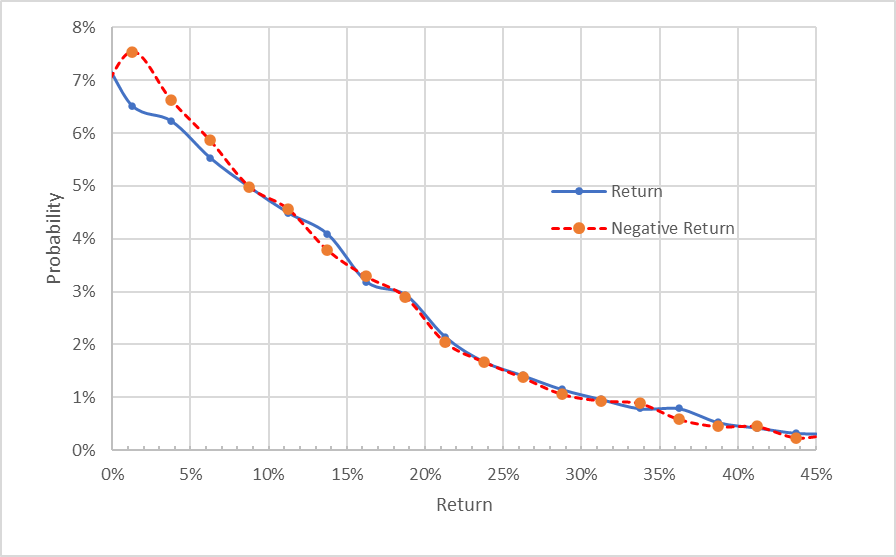- Costco is an incredibly successful and well-run company
- Shareholders have enjoyed very high returns as the firm builds out e-commerce offerings
- The company is valued more like a tech firm than a traditional retailer
- The share price currently exceeds the Wall Street consensus 12-month price target
- The market-implied outlook, representing the consensus view from the options market, is slightly bullish to mid-2022, but is slightly bearish for the full year
Costco Wholesale (NASDAQ:COST), the membership warehouse chain with outlets worldwide, has had an enormous run-up over the past 12 months, with a total return of 52.9%. The company reported FY Q1 2022 results on Dec. 9, 2021, exceeding the consensus expected EPS by 12.9% according to E-Trade.
The Wisconsin-based company has successfully navigated the shift to e-commerce in recent years, a key transition for brick-and-mortar retailers. With this rapid growth in e-commerce, the market has reevaluated the shares. With the extreme growth potential and economies of scale provided by web-based selling, the market has gotten comfortable with much higher share prices relative to current earnings for COST. Berkshire Hathaway’s Charlie Munger predicts that COST will continue to grow as a leader in online retail.

Source: Investing.com
While it is hard to find anything not to like in the company’s execution, the shares have risen to fairly extreme valuation levels. COST has a trailing 12-month P/E (TTM) of 47.35, substantially higher than the P/E ratios of Apple (NASDAQ:AAPL), Microsoft (NASDAQ:MSFT), Alphabet (NASDAQ:GOOGL) (NASDAQ:GOOG), and Facebook parent Meta Platforms (NASDAQ:FB).
Amazon’s (NASDAQ:AMZN) P/E, 66.9, is still substantially higher than COST’s, however. COST is also slightly cheaper relative to earnings than Walmart (NYSE:WMT) (P/E of 48.8).

Source: Investing.com
Investors need to recognize, however, that Costco is not Amazon. Amazon is much broader than just an online retailer. Amazon Web Services (AWS) is a leader in cloud storage and analytics, a major source of growth. Amazon has also created the de facto standard for e-books and produces the Kindle devices for reading this format.
There is no question that COST is a great company, but no company is so good that no share price is too high.
When I analyzed COST in early March of 2021, Costco stock had a P/E of 31.9 and the shares were 20% below the 2020 highs. The Wall Street analyst consensus was bullish, with expected 12-month price appreciation of 20%. The market-implied outlook (derived from options prices and described below) for COST to early 2021 was neutral, with low volatility.
I gave COST a bullish rating. When I revisited COST in mid-September, 6-½ months later, the shares had risen 41%. At that level, the Wall Street analyst consensus 12-month price target was almost exactly equal to the share price. In other words, the shares had already priced in the next 12 months of expected growth, although the rating remained bullish.
The market-implied outlook for COST was bullish to January of 2022, shifting to neutral for the outlook to June of 2022. I changed my rating on COST to neutral, largely due to valuation. The P/E was 41 at that time. Since my September analysis, the shares have gained another 23.7%.
For those who are not familiar with the market-implied outlook, a brief explanation can motivate the approach. The price of an option on a stock reflects the market’s consensus estimate of the probability that the share price will rise above (call option) or fall below (put option) a specific level (the strike price) between now and when the option expires. By analyzing the prices of put and call options at a range of strikes, all with the same expiration date, it is possible to calculate a probabilistic price forecast that reconciles the options prices. This is the market-implied outlook and represents the consensus views of buyers and sellers of options.
As we reach the end of 2021, I have updated the market-implied outlooks for COST to provide a view to the middle of 2022 and to early 2023. As in my previous posts, I compare the market-implied outlook to the Wall Street analyst consensus rating and 12-month price target.
Wall Street Consensus Outlook For COST
E-Trade calculates the Wall Street consensus outlook by combining the views of 25 ranked analysts who have published ratings and price targets for COST over the past 90 days. The consensus rating continues to be bullish, but the 12-month price target is 0.82% below the current price. Of the 25 analysts, 19 assign a buy rating and 6 rate COST as a hold.

Source: E-Trade
Investing.com’s version of the Wall Street consensus is calculated from the views of 35 analysts. The consensus rating is bullish and the consensus price target is 4.9% below the current price.

Source: Investing.com
Both of these Wall Street analyst consensus outlooks agree, providing the stock with a bullish rating, but a 12-month price target that is below the current level. This situation typically arises when the analysts view a company’s long-term prospects as favorable, even though the share price has risen to the point that the entire next year’s expected growth is priced in.
Market-Implied Outlook For COST
I have calculated the market-implied outlook for the next 5.7 months (using options that expire on June 17, 2022) and for the next 12.8 months (using options that expire on Jan. 20, 2023). I selected these two option expiration dates because they were the closest to the middle of 2022 and for the next year, respectively.
The standard presentation of the market-implied outlook is in the form of a probability distribution of price return, with probability on the vertical axis and return on the horizontal.

Source: Author’s calculations using options quotes from E-Trade
The market-implied outlook to the middle of 2022 is very symmetric, with similar probabilities of positive and negative returns of the same size, although the peak in probability is very slightly tilted to favor negative returns. The annualized volatility calculated from this distribution is 26.5%.
To make it easier to directly compare the probabilities of positive and negative returns, I rotate the negative side of the distribution about the negative axis (see chart below).

Note: The negative return side of the distribution has been rotated about the vertical axis (Source: Author’s calculations using options quotes from E-Trade)
This view shows that the probabilities of positive and negative returns of the same magnitude are almost identical (the solid blue line and solid red line lie almost on top of one another), although there are very slightly elevated probabilities of small-magnitude negative returns (far left of the chart). In my September analysis, I calculated an outlook using the June 17, 2022 option expiration date and that outlook was very similar to what we see here.
Theory suggests that the market-implied outlook will have a negative bias due to investor risk aversion, such that the market prices of put options will be higher than the expected value. As such, a symmetric market-implied outlook (as seen here) is interpreted to be slightly bullish. This outlook is notably less bullish than the 3.9-month outlook for COST calculated in September, however.
The market-implied outlook through 2022, calculated using options that expire on Jan. 20, 2023, exhibits more elevated probabilities of negative returns (the dashed red line is persistently above the solid blue line for a wide range of the most probable outcomes). The annualized volatility calculated from this distribution, 27.3%, is consistent with the mid-year outlook. With consideration of the expected negative bias, I interpret this market-implied outlook as neutral to slightly bearish.

The negative return side of the distribution has been rotated about the vertical axis (Source: Author’s calculations using options quotes from E-Trade)
The market-implied outlook for COST to the middle of 2022 is slightly bullish, but the view to early 2023 has shifted to be slightly bearish. The expected volatility is consistent and quite low for both periods.
Summary
Costco is widely admired and shareholders have been well-served. At the current high valuation, however, it is hard to be bullish.
The Wall Street analyst consensus is bullish, but the consensus 12-month price target is below the current share price. The market-implied outlook for COST to the middle of 2022 is slightly bullish, but the view to early 2023 is slightly bearish. The expected volatility is modest.
Considering the valuation, the high share price relative to the analyst price target and the longer-term market-implied outlook, I am maintaining my neutral rating on COST. It will not be surprising to see some near-term gains in the share price given the positive momentum and the slight bullish tilt in the market-implied outlook to mid-year, however.
